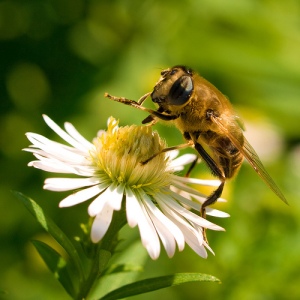 In my last post, I looked into in the case of the mysterious bee disappearances: colony collapse disorder. I found that the latest research frames a popular class of pesticides–neonicotinoids–as prime suspects And we know that these bee die-offs threaten our food security, as well, since we depend on bees to pollinate so many of our crops.
In my last post, I looked into in the case of the mysterious bee disappearances: colony collapse disorder. I found that the latest research frames a popular class of pesticides–neonicotinoids–as prime suspects And we know that these bee die-offs threaten our food security, as well, since we depend on bees to pollinate so many of our crops.
The next question is, how did neonics make it onto the market, and why are they still being sold? Pesticides in general are very common and very rarely a good thing, but not all have the distinction of threatening such a crucial natural service as pollination. Why didn’t the folks at EPA see this coming?
Well, actually, they did.
The Story
Let’s focus on Bayer’s clothianidin, one of the most common neonics. When Bayer first applied for registration of the chemical in 2003, EPA refused, citing concerns about (guess what?) clothianidin’s impact on bees.
But just two months later, EPA granted clothianidin “conditional registration,” trusting Bayer to conduct its own “chronic life cycle study.” Even as they approved the pesticide for sale, EPA scientists noted clothianidin’s “persistent” and “toxic” effects on bees.
Bayer, of course, started rolling out clothianidin that spring. And the life cycle study didn’t show up until 2007. By that time, billions of plants were producing pollen laced with clothianidin.
When the study finally arrived, it essentially claimed that clothianidin was harmless to bees. Experts outside of the government found serious problems with the methodology. Yet, EPA deemed the research “scientifically sound” and quietly gave clothianidin full registration in April 2010.
Now we get to the interesting part. In a leaked memo [PDF] sent on November 2, 2010, two EPA scientists repeated concerns about clothianidin’s “potential for long term toxic risk to honey bees and other beneficial insects.” Here’s what they said about the Bayer study [emphasis mine]:
…after another review of this field study in light of additional information, deficiencies were identified that render the study supplemental…. Another field study is needed to evaluate the effects of clothianidin on bees through contaminated pollen and nectar. Exposure through contaminated pollen and nectar and potential toxic effects therefore remain an uncertainty for pollinators.
So EPA scientists basically rejected the study that led to clothianidin’s registration. And independent research confirms that neonics are dangerous to bees. But so far, EPA has no plans to reconsider the use of neonics.
That may change soon, since beekeepers and environmental groups are petitioning the agency to ban neonics until a scientifically sound review is completed. If EPA does not respond, the petitioners could sue under the Federal Insecticide, Fungicide and Rodenticide Act and the Endangered Species Act.
The Takeaway
Clearly, neonics should be taken off the market as soon as possible. Beyond the obvious, I can make two more points based on this story.
First, it is absurd to say EPA should be more “industry-friendly.” The agency was too friendly toward Bayer, and our food security is now threatened as a result. (Granted, a lot of this happend under the Bush Administration. Whether the Obama EPA acts more responsibly remains to be seen.)
Second, the ecological threat of pesticides should be taken seriously, and enforcement should be a priority. This isn’t about “conservation”; it’s about, quite literally, saving the humans.
What if the FBI had uncovered some terrorist plot targeting a third of our food supply? The defense budget would skyrocket. Congress would pass emergency laws and launch an investigation. John McCain would be calling for war.
Instead, we hear about the EPA bureaucrats strangling the economy. Republicans in Congress want to slash the agency’s budget, and many want to eliminate it altogether. Most recently, Tea Party Representative Stephen Fincher said “We must cut the EPA’s legs off.”
Pardon me for saying that this borders on lunacy.
If anything, EPA needs more resources, not less. In any case, we need much more thorough oversight of potentially devastating pesticides in the future.
What you can do: For more details on this story, I’d highly recommend Tom Philpott’s article for Grist. If you feel the urge to act, you might want to sign this petition asking EPA to prohibit neonics.
Image: Cygnus921




